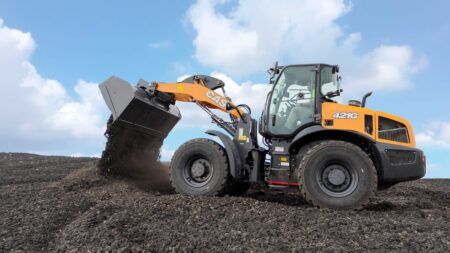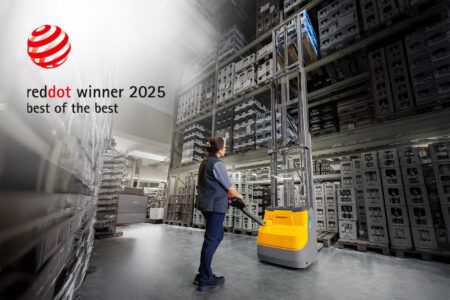Terex Port Solutions (TPS) has presented the four latest members of its new-generation lift-trucks: the Terex Stackace E 5?8, E 6?8, E 6?9 and E 7?9 empty container handlers, which will replace the Terex FDC 18K5, FDC 18K6 and FDC 25J models.
Like the Terex Liftace 5?31 reach stacker (see here for more information) the new-generation machines combine the strengths of their respective predecessors with many innovations. They are cost-effective, serviceable and ergonomic, and the easily maneuverable vehicles feature a compact construction and a maximum load capacity of 8 or 9t on spreader. They offer low fuel consumption and wear, particularly easy access to all maintenance points, and a cab with a user-friendly design. With a wheelbase of 4,000 or 4,500mm, the Stackace empty container handlers achieve stacking heights of between 1-over-4 and 1-over-6 standard empty containers (8’6″).
The maximum lifting speed has been increased by almost 30% compared to their predecessors. Klaus Peter Hoffmann, vice president and managing director, TPS, said, “The improved lifting speed is only one example of the added value that we are offering customers, with the new empty container handlers in particular and with the new-generation lift trucks in general. Our productive Stackace machines help terminal operators accelerate processes in terminals and handle containers even more efficiently than before.”
Despite their significant increase in performance, the fuel consumption of the four new Stackace empty container handlers has been considerably reduced. This is thanks to their modern drivetrain combined with the load-sensitive hydraulic system. It is possible to reduce fuel consumption even more by using the optional eco-mode package. In addition to the EcoPower operating mode, the eco-mode package includes an automatic engine cut-out and lights-off function. The low tire wear also contributes to long-term cost reduction; this is primarily a result of the well-tuned interplay of the engine and gearbox with the drive axle, and good load distribution.
With all new Terex empty container handlers, TPS combines modules from its own production with high-quality components from renowned suppliers. The machines have state-of-the-art engines from Volvo and Cummins, and these are available in EPA Tier 4 final (EU Stage IV) compliant variants.
The chassis, spreader and mast come from TPS; the rugged and durable components make for long maintenance intervals and, as a result, increased availability. All maintenance points are easily accessible, and this means that service work can be carried out easily, with the machine quickly back in operation again.
In addition to service-friendliness, the robust components offer other advantages. Thanks to the particularly rugged mast construction, it is possible to dispense with cross-shaped bracings. As a result, the forward view is considerably improved ad the high positioning of the ergonomically designed cab also contributes to the good view. In this cab, drivers benefit from the intuitive control and visualization system with ergonomic joystick and graphic display designed especially for Terex lift trucks.
TPS offers options including an automated driver identification system, reversing sensors and a camera system. The same technologies and many identical configurations and components are used across all Terex lift truck products.
“Our international engineering team has developed a technical platform and a harmonized control system that serve as a basis for all new Terex lift trucks,” Hoffmann explained.
“Since the vehicles have major points in common, fleet operators, drivers and service technicians can be used flexibly on all vehicles.”
The new empty container handlers are manufactured in Lentigione, Italy, where TPS has combined its global activities for full and empty container handlers and forklift trucks in a new competence center.
“Our combined expertise has been incorporated into our Stackace empty container handlers. Like all of our new-generation lift trucks, they help terminal operators handle containers even more cost-effectively in the face of stiff competition,” said Hoffmann.
April 24, 2015




